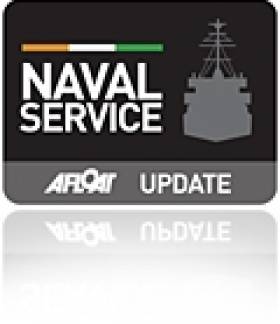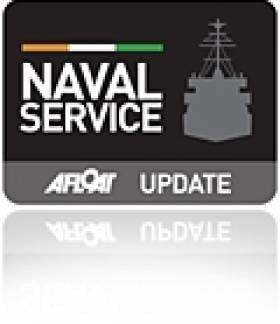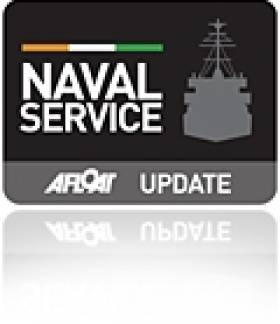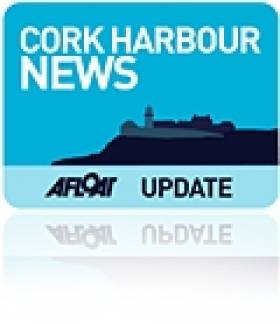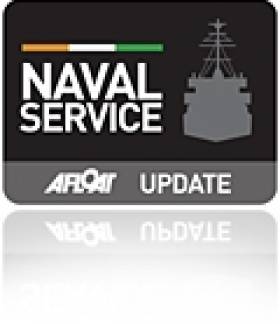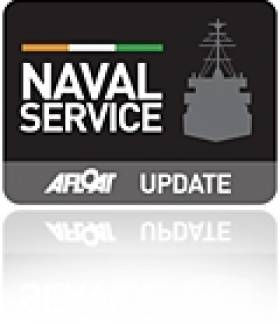Displaying items by tag: naval service
‘James Joyce’ Second OPV90 Newbuild Starts Sea-Trials
#JamesJoyce – James Joyce began builders sea-trials today, she is the second of a trio of OPV90 class newbuilds ordered by the Department of Defence from a UK shipyard, writes Jehan Ashmore.
Afloat.ie has confirmed from the Department that an indicative date for the handover of the yet to be commissioned James Joyce will not be available until the sea trials are completed. She is to directly replace the decommissioned Aoife.
It is understood that James Joyce departed in the early hours of this morning from Appledore, north Devon from where she was built by Babcock Marine & Technology.
The yard on the banks of the River Torridge is from where her predecessor, leadship LÉ Samuel Beckett (P61) was also floated-out in late 2013.
On that occasion the inaugural newbuild also carried similar trials in the Bristol Channel which took place almost a year ago.
As recently reported, LÉ Samuel Beckett is undergoing annual maintenance works at Cork Dockyard.
A final sister also costing €54m was added to the original order for the first pair. The unnamed third newbuild will be launched from Appledore but not due for delivery until 2016.
#Asbestos- OPV90 class LÉ Samuel Beckett (P61) currently in Cork Dockyard for annual maintenance is where previously a pair of Naval Service CPV had asbestos removed early in the year, writes Jehan Ashmore.
Afloat.ie contacted the Department of Defence to comment on the current status of the CPV (Coastal Patrol Vessels). A spokesperson said that the Health & Safety Authority have indicated to the Naval Service that they are satisfied that all ship-related asbestos matters have been dealt with.
The cost to remove the dangerous material which was located in engine room spaces of the LÉ Orla (P41) and sister LÉ Ciara (P42) was in the region of €350,000.
Both CPV's had also undergone routine refit work at the dry-dock before returning last month to the Naval Base on Haulbowline, Cork Harbour, to where further works were carried out.
LÉ Orla is expected to resume operations by mid-March and LÉ Ciara is also expected to re-enter service at the end of this month.
Forget Malta - Send LÉ Aoife To Cork As Floating Museum, Says Mayor
#LÉAoife - Cork county councillors have called for the decommissioned LÉ Aoife to be turned into a floating museum after Maltese military brass branded the vessel as "junk".
"Past its sell by date" is how some members of Malta's armed forces see the 35-year-old OPV that's set to be gifted to the Mediterranean island country to shore up its naval capacity, as previously reported on Afloat.ie.
Now, Cork county mayor Alan Coleman has offered that a tourism group in Cork Harbour could take on the vessel as a museum near the Naval Service headquarters on Haulbowline, in the face of what's been taken as a "snub" by the Maltese.
According to the Irish Examiner, Mayor Coleman has the unanimous support of his council colleagues for the move to write to Marine and Defence Minister Simon Coveney and make a formal offer.
The mayor also expressed his surprise at the gifting of the LÉ Aoife when her sister ship the LÉ Emer was sold at auction for €320,000.
Aoife’s ‘Junk’ Status As the Future Maltese Naval Flagship (P71)?
#AoifeFuture? Should the 'Aoife' set sail for sunnier climes in Malta, despite previous reports of disquiet from Mediterranean military quarters, she would become the island state's largest naval unit, writes Jehan Ashmore.
As flagship, she potentially faces the harsh realities of the growing refugee crisis as people flee war-torn regions across North Africa and also the Middle East.
The Verolme Cork Dockyard OPV L.E. Aoife (P22), custom built in 1979 for the Naval Service has been the longest serving patrol vessel spanning 35 years until decommissioned in her 'adopted' homeport in Waterford last month.
Her possible role in the Armed Forces of Malta (AFM) naval squadron would be to serve in a fleet that is larger than the Naval Service now reduced from 8 to 7 vessels.
The AFM' naval fleet are mostly high-speed yet small inshore patrol boats (IPV) that are strategically positioned in the centre of the Mediterranean Sea. However, there have been calls from a lobby group to keep the Aoife as a museum ship tourist and educational attraction in Waterford City.
Aoife which has a displacement of 1,019 tonnes and a length of 65.5m, would according to the Maltese Government address a shortfall in the capability of having a longer range vessel and given the country's role in UN mandated missions.
Both Irish and Maltese military have shown increased defence co-operation having recently completed a joint exercise as part of an EU training mission in Somalia. Maltese army personnel would be provided peace-keeping training courses from Ireland as part of the deal with Aoife's gifting to Malta.
The transfer of Aoife to Malta, would be a stop gap measure as their navy are to acquire a new OPV but not due for another four years.
By coincidence, another Maltese naval patrol ship with the same pennant number of the former Aoife's P22 already exists as a unit within a quartet of albeit smaller 21m IPV's of only 40 tonnes displacement. Funding for these inshore Austal built aluminium craft came from the European Union External Borders Fund.
While the largest vessel of the Malta Navy fleet is an OPV with the pennant number (P61) which is another coincidence given the same number is also designated to the Irish Naval Service's newest built OPV90 leadship, L.E. Samuel Beckett. Second sister of the trio ordered, 'James Joyce' is to directly replace the Aoife and is due for delivery within months.
When commissioned, the Babcock Marine built newbuild from Appledore in the UK will be designated pennant number P62. As for the yet to announced name for the final OPV due in 2016 and as the P63.
As for the largest Maltese patrol vessel commissioned in 2005, the single P61 class OPV has a 399 displacement and is based from the design of an Italian Coast Guard class 54m cutter. However, she unlike the Aoife, has the advantage of a helicopter deck in addition to a stern ramp for launching a 7 metre RHIB.
This capability along with some other classes can easily deploy a fast-response rescue RIB for the humanitarian crisis. The lack of this feature on the Aoife has been raised as a concern by certain quarters of the navy and by the Maltese media.
With continued negotiations underway between Irish and Maltese departments of Defence, Aoife and 'P71' painted across her bows?
LE Aoife Donation Not Welcome In Malta?
#LEAoife - Ireland's donation of the LE Aoife to Malta is not going down well with military authorities in the Mediterranean island country, according to The Irish Times.
Days ago it was reported that Ireland would be donating the decommissioned Irish Naval Service OPV to help address a shortfall in Malta's current naval capacity as it faces a growing humanitarian crisis in the Mediterranean.
But it's now emerged that members of Malta's armed forces view the 35-year-old vessel as "past its sell by date", with one retired serviceman saying it "sets a very very bad precedent for other junk to follow being dumped on us."
The Irish Times has more on the story HERE.
Commodore Liam 'Willie' Brett R.I.P. 1929 - 2015
The death has taken place of Commodore (Retired) Liam Brett, former Flag Officer Commanding the Naval Service. Commodore Brett was instrumental in the expansion of the Naval Service beginning with the L.É. DEIRDRE in the early 1970s.
He was pivotal in the operations to detain the "Claudia" and the "Marita Anne" IRA gun running ships in the 70s and 80s, and also the Aer Lingus Viscount and the Air India recovery operations in his earlier years before commanding the Naval Service as Flag Officer until 1990.
He retired from the Naval Service after a 44 year career and is survived by his four children, son in law and five grand children.
Factory Trawlers off Blaskets Detained by Naval Service
#FactoryTrawlers –L.E. Samuel Beckett (P61) the newest Naval Service OPV has according to RTE News detained two British-registered factory trawlers for alleged breaches of fisheries legislation today.
The trawlers were detained in a joint operation with the Sea Fisheries Protection Agency, 30 miles west of the Blasket Islands. The trawlers were fishing for pelagic species, such as mackerel.
LE Samuel Beckett is the Naval Service's newest ship and the trawlers are among the biggest vessels boarded by the Naval Service over the past year, each being 55 metres long.
Both trawlers are being escorted to Cobh, Co Cork and are due to arrive Thursday evening.
LE Samuel Beckett was commissioned for service in May 2014 as previously reported on Afloat.ie with coverage of her first patrol following her naming ceremony in Dublin Dublin Port.
#oceanwealth – A major celebration of Ireland's ocean wealth will take place in Cork harbour this summer. A two day event, 10th and 11th July, is planned for Ringaskiddy and Haulbowline in association with IMERC and with support from Beaufort Laboratory, UCC, the National Maritime College of Ireland, the Naval Service and the Marine Institute.
The event, held under the auspices of the inter-departmental Marine Coordination Group Chaired by Minister Simon Coveney, is an initiative of Ireland's Integrated Marine Plan – Harnessing Our Ocean Wealth. It will
build on the first annual Our Ocean Wealth Conference which took place in Dublin Castle last July attended by about 500 delegates.
This year the organisers hope to attract a wider audience over the two day event which will include a conference, marine technology expo, investor events, workshops, a seafood festival, family fun, and competitions.
By broadening its scope to include a range of activities open to families as well as business and potential investors, the event aims to highlight the social, cultural and economic benefits of Ireland's marine sector and provide a platform for public engagement with Ireland's marine resource.
This event is also an action in the Government's recently launched Action Plan for Jobs 2015.
Naval Service’s Longest Serving Vessel L.É. Aoife Decommissioned
#Decommissioned – Naval Service OPV LÉ Aoife (P22), the longest-serving vessel in the fleet has been decommissioned at a special ceremony yesterday in Waterford City, reports RTE News.
In 35 years of service to the State she travelled in excess of 600,000 nautical miles, an equivalent of circumnavigating the globe 28 times, and her crew has boarded over 4,700 vessels at sea and detained over 440 fishing vessels.
During her service L.É Aoife was involved in numerous successful operations, primarily involving her role as a fishery protection vessel, but also search and rescue missions, most notably, the recovery in 1985 of the black box from Air India Flight 182 off the south west coast.
She departed Dublin Port on a farewell call during the week to her adopted homeport where the decommissioning ceremony took place. For more coverage by RTE click HERE.
Afloat.ie adds like her predecessor, L.E. Emer (P21) sold at auction in 2013, they were deployed on re-supply missions to Irish troops serving overseas with the United Nations in particular Lebanon.
The second of a trio of 'Emer' class offshore patrol vessels (OPV) she was built by Verolme Cork Dockyard and each of the 65m OPV's had a crew compliment of 46 (5 officers).
Now that the 'Aoife' has bowed out this leaves L.E. Aisling (P23) as the surviving sister to soldier on in the current reduced fleet of seven ships.
A pair of replacement newbuilds of the OPV90 'Beckett' class are on contract from Babcock Marine in the UK.
A date for Aoife's auction has yet to be confirmed. Her successor James Joyce is due for delivery in March this year.
The final and as yet to be announced name for the third newbuild is to enter service in 2016.
L.É. Aoife Makes Final Farewell Visit to Dublin Port
#FarewellDublin – Naval Service OPV L.É. Aoife (P22) departed Cork Harbour to make an overnight final farewell visit to Dublin Port before the OPV's decommissioning in Waterford this Saturday, writes Jehan Ashmore.
Her arrival to the capital close to last midnight had echoed that of leadship offshore patrol vessel sister, L.É. Emer (P21) which also berthed on the Liffey in 2013. She was sold at auction in 2013 to Nigerian interests.
Unlike her predecessor's Dublin farewell visit, L.É. Aoife in comparison made a shorter call.
The call was less than 24 hours and in which saw the 65m OPV berth at Sir John Rogerson's Quay. No doubt the historic naval occasion was marked to highlight a career spanning 35 years since her entry into service during November 1979.
At lunchtime L.E. Aoife departed the port and also bid Dublin Bay farewell for the last time in blustery conditions.
She set a course to pass Dalkey Island. From offshore of that coastal suburb and the Muglins Lighthouse, she continued on the coastal shipping lane bound for the south-eastern inland port.
Waterford City is the adopted homeport of L.É. Aoife and as reported yesterday, the Suir will set an appropriate scene for Saturday's afternoon decommissioning ceremony.


























